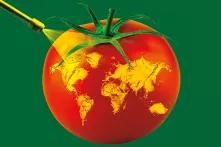
Women working in agriculture often have lower levels of income and lack decision-making power. There is urgent need for gender equality to achieve food security and protection from pesticide exposure.

Women make up 43 percent of the global agricultural labour force, with almost 70 percent of employed women in South Asia and more than 60 percent of employed women in Sub-Saharan Africa working in agriculture. However, women’s participation in agriculture is likely underestimated. Subsistence agriculture, unpaid family work, and seasonal labour, which frequently involve women and girls, often go unaccounted for.
Be it in subsistence farming, informal or formal employment, women are routinely exposed to toxic pesticides. Women carry out a significant part of pesticide application in certain countries and sectors, for example on coffee and fruit farms in South Africa, banana plantations in Costa Rica, or in Malaysia, where there are an estimated 300,000 women sprayers in the plantation sector. A study found that women plantation workers in Indonesia, Malaysia, and the Philippines are frequently exposed to Highly Hazardous Pesticides (HHPs) through mixing, loading, and spraying pesticides. Employers often do not provide Personal Protective Equipment (PPE), so women improvise by wrapping scarves around their faces or using bra cups as masks or respirators.
Women can also be unknowingly exposed to pesticides through activities like weeding and harvesting which does not require PPE. Women in flower farms in Kenya are more involved in weeding, flower cutting and packaging and showed a higher frequency of poisoning symptoms than men that do the actual spraying.
Recent figures on unintentional acute pesticide poisoning estimate that 385 million or roughly half of the world’s farmers and farmworkers are poisoned each year. However, there is insufficient data to estimate the incidence of poisoning for women because there is a lack of gender-disaggregated data and gender perspective in occupational health research.
Due to traditional gender roles, women are more exposed to pesticides through household chores such as washing spraying equipment or their husbands’ pesticide-soaked clothes, storing pesticides, or disposing pesticide containers. In Vietnam, a study found that more girls reported exposure to pesticides from washing spraying tanks compared to boys.
Studies in Bolivia, South Africa, and Tanzania also reveal that lower literacy rates and limited access to training increase women’s vulnerability to pesticides. Women were unable to identify the names of the pesticides they were using, and unable to read or understand safety information on labels.
The impact of pesticides on women and girls differ from the impact on men and boys. Women generally have a higher proportion of body fat, and are thus more likely to store pollutants that can bioaccumulate in fat tissue. Women have a higher level of hormonally sensitive tissues that make them more vulnerable to pesticides, especially those that are hormonally active or known to disrupt the endocrine system. There is an established link between breast cancer and certain pesticides, which act as mammary carcinogens and tumour promoters. Residues of organochlorine pesticides, which degrade slowly and bioaccumulate in the food chain, including banned pesticides such as DDT, have been found in women breast cancer patients. Pesticides are also linked to endometriosis, a painful condition that may cause infertility and can pose a significant risk to women’s reproductive health and their unborn child. Passed on from mother to child through the womb and breastfeeding, pesticides are linked to neonatal deaths, birth defects, and impaired mental development or pervasive developmental problems in children. Studies in the emerging field of epigenetics also show that pesticides exposure may affect gene activity and affect inherited physiological traits.
Women are recognized as playing a key role in transitioning to agroecology – and rural women in the Global South have taken the lead in eliminating pesticides use. Such movements are of benefit not only to farmers, but future generations whose welfare rests upon the health and well-being of women.

